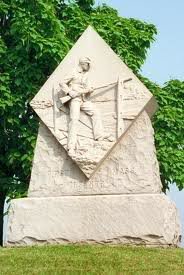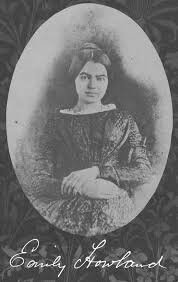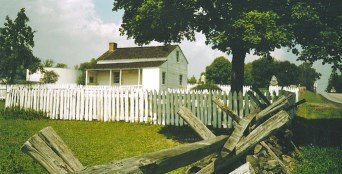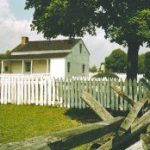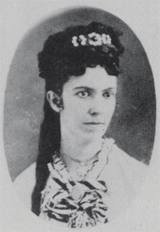Wife of Union General Henry Warner Slocum
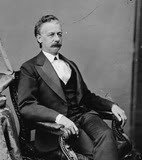 Henry Warner Slocum was born on September 24, 1827, in Delphi Falls, New York. He was the sixth child of eleven born to Matthew Barnard Slocum and Mary Ostrander Slocum.
Henry Warner Slocum was born on September 24, 1827, in Delphi Falls, New York. He was the sixth child of eleven born to Matthew Barnard Slocum and Mary Ostrander Slocum.
Image: General Henry Slocum
Along with the other children in the area, Henry attended the Delphi Public School. In addition to school, Henry helped out in his father’s store. To raise extra money, he raised sheep. Henry attended Cazenovia Seminary in nearby Madison County, and at age 16 received a Public School Teacher’s Certificate. He worked as a teacher in the winter of 1847-48 in a one-room school in the hamlet of New Woodstock.
In 1848, Henry Slocum received an appointment to the United States Military Academy at West Point. He finished 7th in a class of 43 cadets. With only 16 demerits for his entire academy career, he finished twentieth out of two hundred and twenty-four. Although he graduated a year later, future Union General Philip Sheridan was for a time Slocum’s roommate. In his memoirs, General Sheridan wrote, “Good fortune gave me for a room-mate a cadet whose education was more advanced than mine, and whose studious habits and willingness to aid others benefited me immensely.”
When Henry Slocum graduated from West Point, he was commissioned a second Lieutenant in the First United States Artillery on July 1, 1852. His first assignment was to Fort Meade, Florida, where he participated in the Third Seminole War. In 1853, his company was sent to Fort Moultrie, South Carolina, located in Charleston harbor. While stationed in South Carolina, Henry studied law with a local attorney named B.C. Presley.
In 1854, on a trip back to his home in upstate New York, Henry Slocum married Clara Rice of New Woodstock, a former classmate at Cazenovia Seminary. Promoted to first lieutenant on March 3, 1855, Slocum was beginning to consider a legal career.
Back in Charleston, during the unusually warm summer of 1855, Clara and daughter Caroline both became ill, and then word came that Henry’s unit was to be sent back to Florida. In October of 1856, young Caroline died. Eleven days later, Henry Slocum resigned from the United States Army, and he and Clara settled in Syracuse, New York. With money he had saved, he bought a modest house there.
Slocum was admitted to the New York bar in 1858, and practiced law in Syracuse. In November of 1858, he began his political career with election to the New York State Assembly. In 1860, he was elected to a three-year term as Treasurer of Onondaga County. He also served as an Artillery instructor in the New York Militia with the rank of Colonel.
With the beginning of the Civil War in 1861, Henry Slocum immediately volunteered to raise a regiment of light artillery, but was turned down by Governor Morgan, who believed that the war would be of short duration. The 27th New York Volunteer Infantry from Elmira then elected Slocum as their Colonel, although he was a complete stranger to the officers in the regiment.
On July 10, 1861, the regiment left Elmira for Washington, DC, and on July 21, Slocum led the regiment in Major General David Hunter’s division in the First Battle of Bull Run, where his regiment suffered 130 casualties.
After receiving a wound to his left thigh while at the head of his regiment, Slocum was removed to a hospital in Washington where he wrote his wife, “I am bolstered up in bed, making my first attempt at writing. I am as happy as a clam in high water. My regiment covered itself with glory. It was one of the first in, and last out. Not a man showed the white feather.” The Colonel returned home to Syracuse to recuperate, and was on sick leave from July 22 to September 10, 1861.
In August 1861, Slocum was appointed brigadier general of volunteers, and his unit served in the Defenses of Washington, September 1861 to March, 1862. He commanded the Second Brigade, Major General William B. Franklin’s First Division, I Corps, during the Peninsula Campaign (March through July 1862). Slocum led the First Division, VI Corps, at the Seven Days Battles, distinguishing himself at the Battle of Gaines’ Mill on June 27, 1862.
On July 25, 1862, Slocum was appointed major general of volunteers to rank from July 4. He was only 34 years old, the second youngest man in the Army to achieve that rank. Thus, in one of the most meteoric rises of any man in the history of the war, Slocum had gone, in the space of one year from October 1861 to October 1862, from regimental commander to brigade commander to division commander to corps commander.
On September 14, 1862, at Crampton’s Gap during the Battle of South Mountain, Slocum and his subordinate officers overrode their indecisive corps commander, General Franklin, by assaulting the enemy line behind a stone wall and routing it. About the charge, General Franklin wrote, “…the advance of General Slocum was made with admirable steadiness through a well directed fire from the enemies batteries on the Mountain…The enemy was driven in utmost confusion from a position of strength…The pass was cleared and in possession of our troops.”
On October 20, 1862, Slocum assumed command of the XII Corps after its commander, Major General Joseph K. Mansfield, was killed at the Battle of Antietam, where Slocum’s division was kept in reserve. The Corps mercifully arrived too late for the bloodletting at Fredericksburg, so its first battle under Slocum came the following May at Chancellorsville.
At the Battle of Chancellorsville, where he commanded the right wing of the Union Army, including his corps and those of General George G. Meade and General Oliver O. Howard, a force of 46,000 men. Slocum’s force flawlessly executed a flank march and slipped around and behind Lee, but were told by commanding General Joseph Hooker to wait at Chancellorsville.
General Meade advised an advance into the advantageous open ground beyond the Wilderness, but to do so would have exceeded Hooker’s orders, and this Slocum would not do. In the tragic battle that ensued, Slocum’s Corps fought hard and well, losing nearly three thousand casualties, 21% of its men. Slocum publicly criticized Hooker after the battle, and was one of the “cabal” of generals that attempted to have him removed from command.
When the decision was made to change leadership before Gettysburg, Slocum, who ranked highest, was not seriously considered for the command of the army. Although he had done nothing to cast doubt on his military abilities, nothing marked him for higher responsibility, either. That post was given to Meade, and Slocum graciously consented to serve under him.
Slocum was known as an unassertive, exceedingly careful officer, but he possessed a manner that inspired confidence in his men. Physically, he was “small and rather spare, with black straight hair, and beard, which latter is unshaven and thin, large full, quick black eyes, white skin, sharp nose, wide cheek bones, and hollow cheeks and small chin. His movements are quick and angular, and he dresses with a sufficient degree of elegance,” according to historian Frank Haskell, who described Slocum at the generals’ meeting at Gettysburg. He wore his long hair combed back behind his ears, and had a heavy brown mustache.
At the Battle of Gettysburg, Slocum received criticism for his corps’ slow march to the battlefield on the first day of fighting, July 1, 1863. His habit of maneuvering to avoid tough assignments resulted in an unfortunate incident. Sometime between 1:30 and 2 pm, Slocum received an urgent message from the senior commander on the field, Major General Oliver O. Howard, to come forward with the Twelfth Corps to reinforce the outnumbered Union force. Slocum spent the entire afternoon in hesitation, neither bringing forward his corps nor going ahead himself to take command by virtue of his rank.
Slocum later claimed that he had been unaware of the start of the battle, possibly because of an acoustic shadow caused by intervening hills. Officers on Slocum’s staff, however, reported that by 1 pm they heard the sound of cannon, increasingly heavy musketry fire, and could see smoke rising high over the hills and the bursting of shells. In any event, the receipt of the message from General Howard was clear evidence and unrelated to the acoustic situation. It took the arrival of three additional messengers at Slocum’s headquarters before he moved into action.
General Slocum finally put his corps in motion late in the afternoon, and once on the field about 6:00 pm, he detached Geary’s division to guard the army’s left on Little Round Top, and sent Williams’ division to the army’s right around Wolf’s Hill. Slocum rode to Cemetery Hill, where he relieved Generals Howard and Hancock as commander on the field. As the ranking general on the field, Slocum commanded the army for about six hours after the fighting that day, until Meade arrived after midnight.
Meade planned an attack from the Power’s Hill area into the Confederate left flank, to be led by Slocum the following day, July 2, utilizing the V Corps and the XII Corps as the army’s right wing. Slocum resisted the suggestion, claiming the terrain was too difficult for an assault, but he continued to fancy himself the right wing commander for the rest of the battle, leaving Brigadier General Alpheus S. Williams temporarily in command of the XII Corps.
When Meade ordered Slocum to send the entire XII Corps to assist the defense against CSA Lt. General James Longstreet’s assault on the Union left flank on July 2, Slocum wisely recommended holding one brigade back in its position on Culp’s Hill. This brigade, under Brigadier General George S. Greene, was able to hold out against a massive Confederate assault, but they were able to capture much of the just-abandoned Union breastworks.
Slocum knew nothing of this. He was attending the generals’ meeting at Meade’s headquarters from shortly after 9:00 pm to midnight, and was told afterwards of the new situation. His response was: “Well, drive them out at daylight.” After close planning from Slocum’s headquarters and arduous preparation during the night, the Twelfth Corps did just that, starting with an artillery barrage at daylight on July 3, though it took all morning to force the Confederate veterans back.
After the danger on Culp’s Hill had passed, Slocum’s job at Gettysburg was done. The action passed to the army’s center for the final drama – Pickett’s Charge.
Meade’s report of the battle unintentionally slighted the Twelfth Corps contribution, and Slocum’s reputation was not enhanced by Gettysburg. He was fortunate, however, to have avoided the recriminations that would have followed if the First and Eleventh Corps had not held on July 1 or if Greene had not held firm on the evening of July 2.
In September 1863, the XI Corps and XII Corps were sent to Tennessee, under the command of Joseph Hooker. When Slocum found out he was going to be serving under Hooker again, he submitted two letters of resignation to President Abraham Lincoln, stating his derogatory opinion of Hooker as both an officer and a gentleman. Lincoln refused the resignation and assured Slocum he would not have to serve under Hooker. A compromise was reached whereby one division of the corps, under Slocum, was assigned to protect the Nashville and Chattanooga Railroad, while the other division served directly under Hooker.
When Major General James B. McPherson was killed in action July 22, 1864, during the Atlanta Campaign, command of Army of the Tennessee opened up. When Hooker did not get it, he resigned his commission. General William T. Shermanselected Slocum to command the new XX Corps (formed from the remnants of the XI Corps and XII Corps). Slocum’s former XII Corps men cheered their previous commander’s return. When Atlanta fell to Sherman on September 2, 1864, Slocum’s corps was the first to enter the city.
At the start of the Franklin-Nashville Campaign, Sherman left Slocum in command of 12,000 troops in Atlanta, while Sherman pursued CSA Lt. General John Bell Hood and his army. Sherman later placed Slocum in command of the newly created Army of Georgia, comprised of the XX Corps and the XIV Corps from the Army of the Cumberland, which served as the left wing in Sherman’s March to the Sea and Carolinas Campaign. The other wing, consisting of the XV and XVII Corps of the Army of the Tennessee, was commanded by Oliver O. Howard.
Sherman’s March to the Sea brought unparalleled disaster to the Southern countryside in the army’s path. Yet Slocum exhibited compassion. On November 7, he wrote his wife Clara, “I wish for humanity’s sake that this sad war could be brought to a close. While laboring to make it successful, I shall do all in my power to mitigate its horrors.” On December 22, with Slocum presiding over the city’s surrender, Sherman wired President Lincoln, “I beg to present you as a Christmas gift the city of Savannah…”
During the Carolinas Campaign, Slocum’s army was heavily engaged at the Battle of Averasboro and the Battle of Bentonville, where Slocum successfully held off a surprise assault by CSA General Joseph E. Johnston. A fellow officer wrote, “The Battle of Bentonville was General Slocum’s fight… The bloody combat… was peculiarly his own affair, out of which he has come with fresh laurels.”
Although the Army of Northern Virginia under Robert E. Lee had already surrendered, General Joseph E. Johnston’s army continued to fight. Finally, on April 26, 1865, Johnston surrendered. The Union armies returned to Washington, DC, for the Grand Review. Henry Slocum rode at the head of the Army of Georgia.
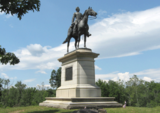 Image: General Henry Slocum Monument
Image: General Henry Slocum Monument
Gettysburg National Military Park
With the war over, Slocum returned to Syracuse to continue his practice of law. He ran as the Democratic candidate for Secretary of State of New York in 1865, but was defeated by fellow Gettysburg General Francis Barlow by a vote of 301,055 to 273,198.
The next year, the Slocums moved to Brooklyn, New York. After resuming work as a lawyer and declining an offer to return to the U.S. Army as a colonel, he was elected to Congress (March 4, 1869 – March 3, 1873). Slocum worked in Congress for the exoneration of Major General Fitz John Porter, who was court-martialed after the Second Battle of Bull Run.
In 1876, Slocum was appointed Commissioner of Public Works in the City of Brooklyn. He was involved in many civic improvements, from surface transportation to the Brooklyn Bridge, where his name is prominent on a bronze tablet. He advocated unsuccessfully for having no bridge tolls.
After traveling in Europe with his family, Slocum returned home to campaign for another Civil War comrade, General Winfield Scott Hancock, who was running for President. Hancock lost the election of 1880 to James A. Garfield.
Slocum returned to politics in 1882, and was again elected to Congress as a Representative-at-Large from New York (March 4, 1883 – March 3, 1885). He was president of the Board of Trustees of the New York State Soldiers’ and Sailors’ Home in Bath, New York, and was a member of the Board of Gettysburg Monuments Commissioners.
Major General Henry Slocum died on April 14, 1894, at his home in Brooklyn. Among the pall bearers at his funeral were Fitz John Porter, Oliver Otis Howard, Daniel Butterfield, and Daniel E. Sickles. He was interred with full military honors at Green-Wood Cemetery in Brooklyn.
A steamship, the General Slocum, was named for him; it had a disastrous fire onboard in 1904 with much loss of life. Fort Slocum, New York, guards the entrance to New York Harbor from Long Island Sound. A statue of Slocum is in Grand Army Plaza, Brooklyn.
SOURCES
Henry Warner Slocum
Major General Henry W. Slocum
Wikipedia: Henry Warner Slocum
The Generals of Gettysburg: The Leaders of America’s Greatest Battle by Larry Tagg. Major General Henry Warner Slocum
